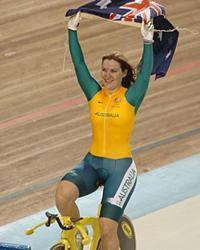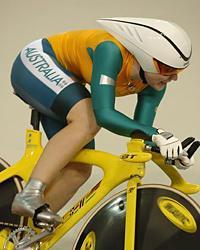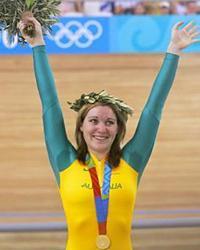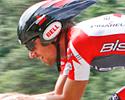
Recently on Cyclingnews.com |
An interview with Anna Meares, November 6, 2004
A household name in under 34 seconds
Part II: The Time Trial, That Bloody Fly, it's a mind game, the coach, where it all started

|
Anna Meares became a household name in less than 34 seconds in August this year.
Until her world record-breaking ride to win the gold medal in the 500m time trial at the Athens Olympics, the 20 year-old had already made a big impression on the cycling scene. As the world champion in the 500m time trial, Anna Meares knew the pressure to perform in Athens would be on.
Together with her coach Martin Barras, she prepared for the prospect of being the last Rider to start this two lap effort. 'Last Ride at the Olympics; 34.1 on the board.' That was the motto in training... and that's exactly what transpired!
Due to space limitations, the full transcript of this two-part interview was not able to be published in the latest issue of Ride Cycling Review, which interviewer and publishing editor Rob Arnold allowed us to use in full below. Part I is here.
Ride: Let's talk about the time trial because that was the most fun. Well, it wouldn't be fun to actually do because it is a painful thing, isn't it?
AM: Yeah, I would say that was the most painful time trial I've ever ridden.
Ride: Can you talk us through the race, the whole 34 seconds of it... well, less.
AM: The race? Well, can I start from the warm-up? That whole day was somewhat nerve-racking. I tried to watch television and I packed my bag three times to make sure I had everything and didn't forget anything. 'Marv' came knocking three times to make sure I had my numbers and my accreditation. I knew Marv was nervous and he knew I was too. And it was pretty funny.
But we got to the track and warmed up in the area underneath the velodrome - away from everyone else, so that when everyone else was going ahead, I didn't see anyone else racing. I didn't see the times coming up on the board.
I just did my own warm-up that I have specialised for my time trial. It's a secret - nah, it involves roller and plyametrics. A series of plyametrics. I took what I thought I would need upstairs for the start of the time trial. And, as they were putting my numbers on with three riders still to go and I said to Marv, 'Oh gee, I forgot my booties'. So he ran downstairs and got them. As soon as he got back, I'm like, 'Jeez, I forgot my gloves'. So he sent someone else to get my gloves but they brought back my warm-up gloves. And I was like, 'No, no. I need my race gloves - they're not my race gloves'. So they had to go back downstairs and get the right gloves.
The nerves were there because I was just fretting about everything. I was starting to think, 'Oh, what have I done - what haven't I done'. But it wasn't too bad. I walked up to the start gate to sit down and I'd just finished watching Simona Krupeckaite and then the Chinese girl, Yonghua Jiang, was up. She is a VERY smooth rider. She doesn't move at all on her bike. When she came through for the first lap, the crowd just went crazy.
"I remember coming out of turn four and looking at the finish line. In between those two moments, I've got nothing but a blank. "- August 20: The Women's 500m Time Trial |
I looked up and saw that she'd done a 19.1. My PB for the lap was a 19.4 which is what I did at the worlds. I just registered it, didn't think about it. And, as the race went on, she got the Olympic record. It was uncanny because the whole time in training we talked about how the difficult task for me was starting last because I was the world champion. I'd never done this before; I'd always been mid-field. So we had to do a lot of mental preparation for that prospect.
The first time we worked on this aspect my breathing was out of whack, I stuffed up the start - I just couldn't get anything right. I was so nervous. We had two months of preparation. I was trying to visualise the other girls riding a particular time and then me going up last.
The first time Marv and I trained like this, I got up there and my hands were sweaty and I couldn't swallow and I mistimed everything. I did the worst start I think I've done all year. I got off the bike and said to Marv, 'Oh my god, that's unbelievable!' I think if I didn't do any preparation, I would have struggled at the Olympics.
We set a benchmark in training. Marv said that he thought I'd be chasing a 34.1 at the Olympic Games. So every time I did a standing start session in training, I was last. I would do mine behind the boys and Marv would always say to me, 'Last ride at the Olympics; 34.1 on the board'. And, luckily for us, on race day the last thing he said to me was, 'Last ride at the Olympics; 34.1 on the board'. It was really funny. Both his mouth and my mouth got a little smirk in the corner because we both were just comfortable with the scenario.
When they put my bike in the start blocks they were so fussy about getting the things in the right place and I was standing there for ages thinking 'Oh, come on. Hurry up!' I was nervous. I was really tight all over my arms and my legs and I was trying to shake them out. I got on the bike and as soon as got my feet clipped in, I was calm.
Ride: Except for that bloody fly...

|
AM: Yeah. There was this little fly that was buzzing around my head. And once I get my hands set on the bars I don't like to move them. I can move my fingers, but I don't like to move the hands. And that damn fly was buzzing around and it was annoying me like crazy.
You can see it on the replay footage; I was turning my head trying to blow it away. By that time it was 10 seconds to go and I got my breathing right, got the start perfect. I remember thinking, the first pedal stroke out of the gate, 'My god this gear feels big!' It was a 91.4 (inch), but I think it was just the nerves and the adrenaline that was pumping through my body at that time - I'd never experienced anything like it. I felt good down the back straight, had a good transition into the time trial bars and, again like the worlds, I knew I was up after one lap. I knew there and then. But it wasn't until I saw it on television a few days later that I knew I was only up by something like about 0.012 of a second but the way that the crowd reacted it was as though I was up by two-10ths of a second!
The crowd really did bring me home on that last lap. I remember going down the back straight and lining up from the transition into turn three. And I remember coming out of turn four and looking at the finish line. In between those two moments, I've got nothing but a blank. I've got no memory of in between those points. I remember the start. The one lap mark. The end of turn three and out of turn four of the last lap. And then I remember looking up at the score board.
I saw a red box next to my name with number one in it. I was so happy! I was havin' a great time. But as I got closer to the scoreboard and trying to look at my time, I saw something - .9, and I thought 'What? -.9? That wouldn't have won it, 34.9?' And it wasn't until I got closer and saw the green 'WR' box. After that I lost it! The hands were waving. I was screaming. I was crying. I didn't know what to do after that. I was having an absolute ball!
Ride: So, was it the Olympics that created the world record? Are you confident that was what did it?
AM: No. I think the training had been going really well leading into the Olympics. Again, a lot of credit goes to Martin Barras and his program. I think I would have done a good time had it been another competition. But you can't speculate on things like that because the Olympics brings out the best in people so, I guess we'll just say that the Olympics bought out the world record.
Ride: Can you talk us through the actual process involved in the various aspects of the time trial. It might be a short race but there's a lot to keep in mind, isn't there?
AM: You generally have to sit down into turn three because the g-forces force you to sit down. But sometimes, when you have a big gear, you don't have it fully wound up by then. Because I ride with time trial bars, if I sat down AND changed from the cow-horn bars to the time trial bar position, I would lose too much power in that split second.
It would take too much to try and get that gear rolling again while on a high cadence in the time trial position. So, I sit down in turn three and pedal it right through the bends because you get so much g-force and sling coming out of the turns. I change into my time trial bars just after the transition because you collect so much speed going through the transition at the bottom of the track.
I do lose a little bit sitting down, but not as much as I would if I sat down AND changed at the same time. I think I make up some time in the transition and the next two bends. Guys like Shane Kelly will do it a bit different because they have a longer race. In the men's race, they can't go out as hard as possible. We've only got two laps, they've got four. So he does it a little bit differently, but it's different for everyone.
"It's different from what I hear of the Charlie era. The way I see it is that Martin has put the onus back on the athlete who is there because they want to be there."- Speaking about Australian head track cycling coach, Martin Barras |
Ride: You said it was the most painful race. When did it start hurting?
AM: Ah, pain from a legs perspective I'd have to say the back straight of the last lap. I really started to feel it then. I have a bit of a deceptive style. It doesn't matter if I'm going slow or fast, I still look the same. So, if I struggle, you can't really tell.
Marv has been working with me now for the last 12 or 18 months and he's been able to pick up on the times that I am struggling on the time trial bars. It's just a slight wobble in the shoulders and the back starts to try and get the legs going a bit easier. But he said to me that he saw me coming out of turn four and he started to get a bit worried because I started to wobble.
Normally, you wouldn't pick it up but because he's trained me every day, he's been able to get used to my style and my technique.
Ride: You talked about preparing mentally for the 34.1 and how it was a real distraction that made you sweat because of anxiety. Then you talk about your routine on race day being interrupted by the fly. I don't mean to make too big an issue of the insect but, here's a thing that makes you think about other things. If approaching those training sessions for the mind was so nerve-racking, how were you able to focus?
AM: I was good about the fly because generally, at the start my focus is turned on from the 10-second mark and from that moment on, it doesn't matter. If the fly was there, it was there. I was trying to get rid of it before that point but it didn't bother me.
Ride: You don't look to be straining as much as others when you're coming out of the gate - particularly Felice Ballanger who used to look as though she'd give herself hemorrhoids the way she used to start - yet you seem to do it quicker. Can you explain that?
AM: I just have a habit of biting my lip. Some people skwinch their face, some people bare their teeth. I bite my lip. And Kerrie has a tendency to open her mouth. It's an individual thing that you do as you get used to the action. It's not something you focus on doing, it just happens.
Ride: When you talk about the local environment, how important is Kenrick Tucker for you?

|
AM: Yeah, he has had an impact but I'm more involved with his father, Ken. But Kenrick was great when we first started cycling because he did teach us some sprint tactics for use down the track. He showed us around the velodromes and taught us the ins and outs of sprint racing but his father has been instrumental for me. He's given me values which I still treasure to this day. Some things I've taken with me, some things I haven't. But he trained me for six years and gave me a platform that was just right for when I went to the AIS.
Ken gave me the building blocks to be able to perform like I do. But that's taking nothing away from [Australian head track cycling coach] Martin Barras who I think is an unbelievable coach. I was a bit hesitant about going down to train with the AIS at first but, looking back on it, I wouldn't have changed it at all. Martin is a great coach and a great guy. It's different from what I hear of the Charlie era. The way I see it is that Martin has put the onus back on the athlete who is there because they want to be there. That's the attitude that we've taken.
Ride: Let's talk about Martin. I've heard him say on numerous occasions that he's going to go and 'massage some minds'. He seems to be very enthusiastic about the mind games. When it comes down to doing that, what process is involved?
AM: With Martin and his approach, it's very individual. Some people like to be spoken to, some don't. Those who do, like to be told to do specific things. For me, this whole year - this whole season - has basically been about just going out to race. Have fun. Don't think about it. Don't worry about coming anywhere. Don't worry about winning or losing, just go out and have fun.
Ride: Is that why you look so confident in the sprint?
AM: I think it's just because I'm out there having a good time. I'm not worrying about 'Oh my god, there are 10 million people watching me and I've got to really perform. And if I don't, there are going to be people who are going to be critical'. I just go out there and if I win, I win. If I lose, I lose. Too bad, I'll come back next year and try again.
Martin has been able to get me relaxed. He's allowed me to take a calm approach and I think this has really given me the opportunity to perform the way that I have this year. He hasn't put any pressure on me at all, which is great.
Being my first year with a full-time AIS scholarship, you would have thought - or I would have - that I would have felt a bit of pressure going into the World Cups or world championships but the last thing he said to me was, 'Have a good ride. See you when you get off'. And when I came off the track at the worlds, he said, 'Mmm, not bad for just another race'. He's not a pressure-styled coach.
Ride: Do you have a BMX background. Is that where it all began for you? That's where it began for me
AM: Yes. It's good isn't it? I haven't done it since I was about nine or 10 but I did it for four years. I still notice the skills that I learned during my time on the BMX track. I always rode with little gears and little tyres; Kerrie rode big gears and big tyres. When she came on to the velodrome - when I was 11 and she was 12 - it was a little different for her but I was used to skinny tyres.
I was five and she was six when we started racing BMX. When I was six, I won the national titles in Melbourne. I won four state titles, so did Kerrie, so did my big sister and brother. We were all BMXers. We went to four national titles, the Queensland country titles lots of things.
Ride: I've often wanted to do a story about the impact of BMX on cycling - both road and track. I think it's enormous, not only from a personal perspective because that's what got me involved
AM: Yeah, it's just because you learn so many skills. The younger kids learn to be able to pedal the gears properly. Some people ride the bigger gears and they struggle. But because it comes in short bursts - between the jumps - it's good for sprint cyclists. Me, Kerrie, Ryan Bayley, Christine Bayley and Darryn Hill a lot of BMX-background people come through and succeed in other forms of cycling.
Ride: Anything else you'd like to talk about?
AM: I would really like it if you could mention my sponsors. Bollé, Musashi and Multiplex have been with me for a long time. They've supported me since I was a junior and that's really unusual for sponsors which normally tend to get involved once they've done something. But these companies have sponsored me when I was young and helped me out right through when I was going through the ranks. It was a god-send. They saved me so many times.
The Bollé association came about after I won the junior world championships. At that stage they were sponsoring a lot of athletes but now they've reduced it to just three sports, yet they kept both Kerrie and I on. They've been good to us and we try to be good to them. Musashi have just been unreal! They've supplied me with all the supplements, the protein bars, the drinks, the amino acids which have really helped with recovery and building of muscle and getting over illnesses. They've been unbelievable.
The protein drinks really help me out when I go overseas and there's not enough food - the Musashi products help me get through to the next session. A lot of thanks go to them.
Multiplex have looked after me ever since I won an Emerging Sport Star Award two years ago. They've been helping me out with anything I've needed to buy like shoes or gym clothing, helmets or flights. This has really helped out because it's hard to get work and keep the money coming in when you're training all the time.
Ian Way Motors gave me a car which is great. They've been really looking after me since I got home. And the QAS and AIS have been really good! And my boyfriend, Mark - he's been great!
I've been away for 11 months in preparation for Athens and in that time I've probably seen him for a collective total of about two and a half months. He stood by me the whole year and I'm very thankful for that. In that time he's not only been my boyfriend, he's been my financial adviser, my bank lender, my psychologist everything! He's a great bloke, he really is.
Ride: When it comes to your diet, are you busy counting calories and planning what your next meal is?
AM: Nah. I've got a lot of trust and faith in Musashi. I've used their products all through my career - at times of a lot of drug testing - and never had any troubles. Generally with food and diet, it's your own responsibility; your own comfort level. I don't eat terribly, but if I feel like having a chocolate or a can of Coke after training - if I feel like I need a sugar hit - then I'll go and have it. If I feel like having a pizza one night, I'll go and have it. I'm not at the stage where I, 'Oh no, it's got too much cheese in it'. If I feel like it, I'll eat it but I don't go stupid about it.
Again, this goes back to Marv where the onus is on the athlete to look after
themselves. I think this is a really good attitude to adopt.
Rob Arnold is the publishing editor of Ride Cycling Review. This article appeared in the latest edition of Ride Cycling Review. For further information about this title and to subscribe, click here
